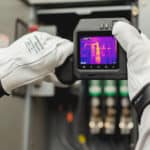What is Enterprise Asset Management?
As organizations scale up production, expand to new regions, and identify ways to reduce costs and improve productivity, the pressure on teams and assets increases. More work and a greater need to manage asset performance for maximum uptime and cost efficiency come with more growth. Organizations should consider a proper enterprise asset management (EAM) solution to achieve those goals and overcome challenges.
EAM solutions are services and processes designed to improve asset reliability, performance, and efficiency and reduce operating, inventory, and maintenance costs. Well-executed enterprise asset management solutions can produce improvements ranging from extended asset lifespans and more effective use of repair technician time to long-term cost savings on replacement parts and more streamlined documentation. Ultimately, EAM helps companies achieve what they’ve set out to accomplish.
What Goes Into an EAM Solution?
While not every program is alike, an ideal program would include several components. First, a predictive maintenance strategy would be established to resolve bad actors (i.e., asset reliability gaps), identify failure points via a failure mode and effects analysis (FMEA) and/or root cause failure analysis (RCFA), and other reliability-focused initiatives. This component aims to prevent teams from dealing with reactive maintenance and unnecessary equipment failures.
A second component of an enterprise asset management solution — and one of the most critical — is a computerized maintenance management system (CMMS). These platforms are nothing new, but it’s important that an organization’s assets, inventory, labor, and other information be centralized in them. Often, companies aren’t using a CMMS to its full extent, so information about maintenance programs and assets isn’t known.
A third component of an EAM solution is a documented process for calibration. This part compares the performance of assets to a standard of known accuracy, meaning that a benchmark is set for when assets and maintenance activities are at optimal levels. Procedures are then set to maintain and improve that benchmark.
The final components of an EAM solution are processes around inventory management and workflow optimization. For managing inventory, it’s important to align parts with asset priority. This ensures that high-priority assets are repaired quickly in the event of a failure while saving resources and warehouse space. Workflow enhancement is focused on increasing one of the driving metrics of every maintenance program: craft productivity or the value received after eliminating non-contributory activities. Effective EAM focuses on improving this as a success metric.
What Are the Long-Term Benefits of EAM Solutions?
1. Improved Reliability
Whether you have one facility or multiple facilities, enterprise asset management solutions help you understand the assets in your footprint, their priority as it relates to business operations, and how to maintain the highest level of productivity and cost efficiency. This allows technicians, facility managers, safety managers, and more to know the best next step when an asset goes down and how to maintain assets proactively.
2. Data Centralization and Management
Companies often have no idea about the number of assets they have. Without this knowledge, there’s no way to repair and maintain them efficiently — let alone take a proactive approach. EAM brings this data into a CMMS for more effective management, reporting, and decision-making. Repair and maintenance activities are centralized, prioritized, and measured using this information. This ensures asset uptime is maximized, costs pertaining to repair and maintenance are analyzed, and leadership can better understand asset performance.
3. Quantitative Baselining
While improvements across the board are desirable, it’s important to know where to begin. Quantitative baselining sets a starting point for asset performance and reliability. Over time, this baseline is used to evaluate the success and progress of a maintenance program, identify areas where adjustments need to be made, and more. Beyond assets themselves, baselining also helps you understand factors about your program, such as pre-existing constraints, the value of change, and more.
4. Refinement Through Calibration
While baselining creates a starting point, calibration gives a north star that shows what accuracy looks like. Through calibration, a point of known accuracy is used to understand how well assets are maintained and ensure that proper processes and procedures are followed. While you likely use an asset management platform, many companies calibrate assets manually, producing inaccuracies, requiring more time and labor, and not achieving goals. As part of an EAM solution, a proper calibration program documents all calibration needs and establishes a program for following them.
5. Inventory Improvements
Every asset has various parts and components needed to keep it running smoothly. Just as it’s important to prioritize maintenance for more critical assets, it’s also important to prioritize parts inventory management. Warehouse shelves are often overstocked with parts that aren’t needed as often. Following a prioritization strategy with inventory means you have what’s on hand when needed. Lower-priority parts can be ordered, or the asset itself can run to failure (RTF). An effective EAM solution evaluates inventory and clarifies what’s needed.
6. Workflow Optimization
Lastly, an enterprise asset management solution identifies obstacles that limit productivity. With only 25-30% of all work hours considered productive, this is one of the best goals an EAM solution can achieve. Anything wasteful is identified and addressed, enabling teams and assets to accomplish more and providing a number of secondary benefits. Numerous production areas are evaluated beyond assets, including emergency response, staffing, skills, planning, scheduling, etc.
Maximize Uptime and Productivity with SEAM Group
As global leaders in enterprise asset management solutions, we can design a full EAM program, implement it throughout your facilities, monitor progress, and provide recommendations along the way for the best results. Learn more about our EAM solutions, or contact our EAM team.





